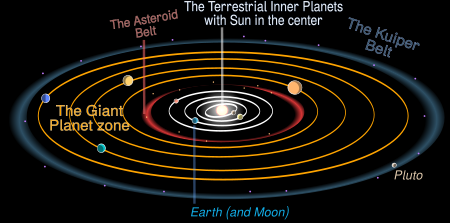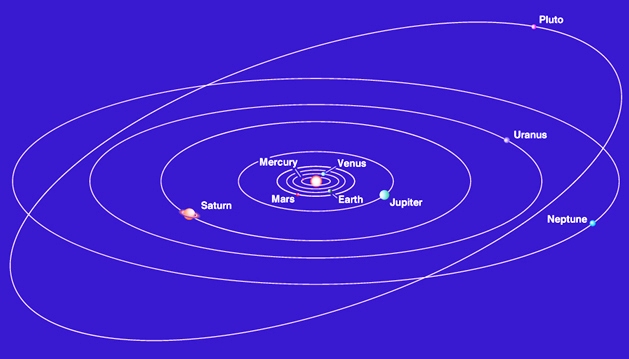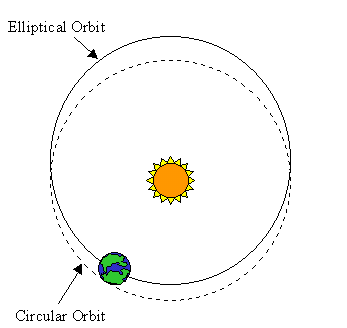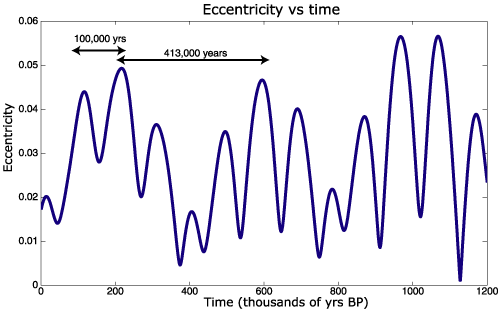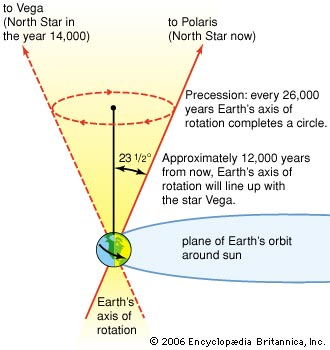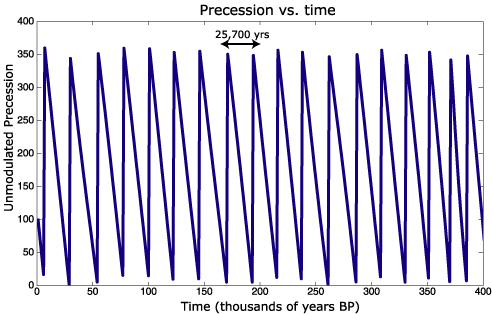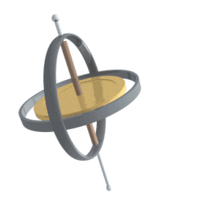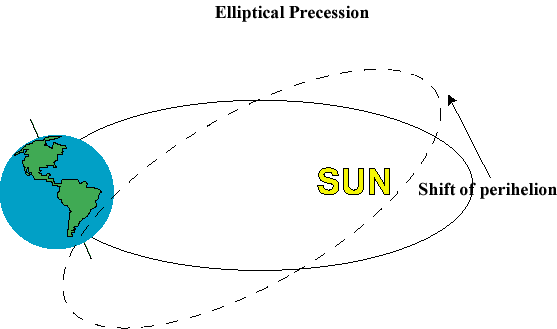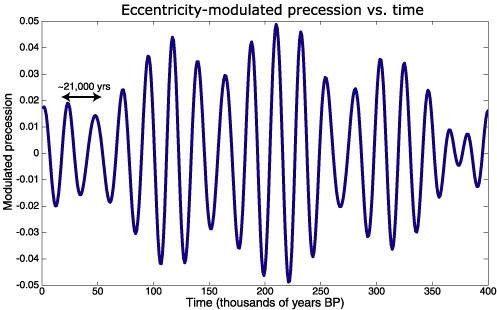I mentioned in a previous post that there is confusion about the periodicities of the precession of equinoxes and the precession of Earth’s axis.
The confusion may be arising because people think that these are the same phenomenon because they are both driven by the axial tilt. In the case of the precession of equinoxes there is another driver: the ellipticity of Earth’s orbit around the sun.
Plane of the Ecliptic
The plane on which all planets of the Solar System revolve around the Sun (Pluto was an exception but it is no longer considered a planet) is known as the Plane of the Ecliptic.
As seen from above the plane of the ecliptic the planets revolve around the Sun in the counter-clockwise direction.
As seen from above the plane of the ecliptic, the Sun itself rotates (spins) around its own axis in the counter-clockwise direction.
As seen from above the plane of the ecliptic, Earth rotates (spins) around its own axis in the counter-clockwise direction as well.
Ellipticity
Earth’s orbit around the Sun is not a perfect circle. In the figure below the ellipticity of the orbit is exagerrated.
At apehelion (when Earth is farthest from the Sun) the distance between the Earth’s center and the Sun’s center is 152,097,700 kilometers (94,509,100 mi).
At perihelion (when Earth is closest to the Sun) the distance between the Earth’s center and the Sun’s center is 147,098,070 kilometers (about 91,402,500 miles).
Currently, the perihelion is reached approximately 14 days after the December Solstice and the aphelion is reached approximately 14 days after the June Solstice. This may be confusing to people living in the Northern Hemisphere of Earth because January is cold and July is warm in the Northern Hemisphere. We might think that when Earth is farthest from the Sun at aphelion in July it should be colder. The surface temperature on Earth has nothing to do with apehelion or perihelion. The surface temperature on Earth is related to the axial tilt which will be explained below.
Currently, summer time in the Northern Hemisphere happens around the aphelion when the Earth is farthest from the sun. In 11.5 thousand years the Northern Hemisphere summers will be occurring near the perihelion again. That was the situation 11.5 thousand years ago as well. This follows the 23 thousand year cycle of the precession of the equinoxes which will be explained at the end of this article.
Eccentricity
The numbers for the ellipticity (the difference between the aphelion and perihelion distances) are not constant. The ellipticity changes in time. The shape oscillates between “less elliptic” and “more elliptic” with a periodicity of 100 thousand years.
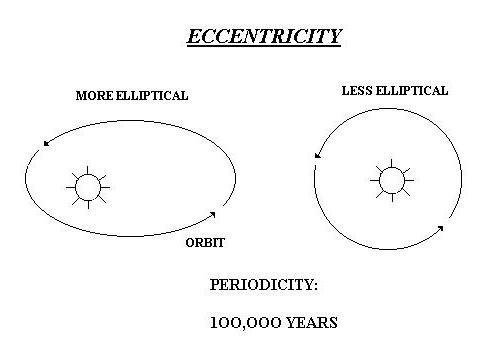 The cycle of eccentricity looks like the following
The cycle of eccentricity looks like the following
Axial Tilt or Obliquity
The angle between the Earth’s equatorial plane (or the celestial equator as shown in the figure below) and the ecliptic plane is called obliquity and currently is 23.44 degrees. The angle of obliquity is the same as the angle between the Earth’s spin axis and the ecliptic axis. The obliquity and the axial tilt refer to the same thing.
The axial tilt causes seasons because the tilt determines the amount of solar energy deposited per square-meter on a given location on the Earth’s surface, especially in locations away from the equator. This quantity is referred to as “solar insolation”. The axial tilt and the solar insolation are directly related.
Axial tilt oscillates (wobbles)
The axial tilt (obliquity) of Earth oscillates between 22.2 and 24.5 degrees with a period of 41 thousand years. The axial tilt angle is currently decreasing. This is the main wobble of the axis. There are other wobbles like the Chandler and Markowitz wobbles.
If the tilt angle is oscillating with a 41 thousand year period than the solar insolation is oscillating with a 41 thousand year period as well. There is a theory known as the Milankovitch Cycles that studies the changes in solar insolation and connects them to ice ages.
The physical cause of the wobbles is the bulging of the Earth near the equator. The bulging was originally formed because of Earth’s rotation around its axis. The Sun, the Moon and the other planets exert a pull on the Equatorial bulge trying to align the equatorial plane with the Ecliptic plane. Angular momentum created by Earth’s rotation around its axis and Earth’s revolution around the sun resists these pulls. The result is a complicated motion of the spin axis in space.
Axial tilt vector changes direction in space slowly
One component of the complicated motion of the axis in space is known as the precession of Earth’s axis. Earth’s spin axis traces a conical area in space around the rotation axis of the solar system. This motion (Earth’s Precession) is similar to the precession of a spinning top. The difference is that the Earth’s Precession is very slow. It takes about 26 thousand years for the Earth’s axis to point to the same location in space.
As seen from above the plane of the ecliptic, the precession of Earth’s axis is a clockwise motion.
The precession cycle looks like the following
Precession of the Ellipse
While Earth’s spin axis is rotating clockwise around the solar axis with 26 thousand year periodicity the ellipticity of Earth’s orbit changes with 100 thousand year periodicity. The ellipticity changes in such a way that it appears as if the ellipse is rotating counter-clockwise. This motion is known as the “Precession of the Ellipse”.
The physical cause of “Precession of the Ellipse” is the gravitational pull of the Jupiter and the Saturn. These heavy planets interfere with the pull of the Sun and complicate Earth’s orbital motions.
Precession of the Equinoxes
Since the clockwise rotation of Earth’s axis is opposite to the counter-clockwise rotation of the orbital ellipse the resulting periodicity is known as the “Precession of the Equinoxes” which is 23 thousand years.
This is why the seasons shift slowly over the years and if the calendar is not adjusted equinoxes shift 6 months every 11500 years. The calendars have been adjusted in the past. Calendars will be adjusted again in the future.
There is actually a great variation in the periodicity of the cycle known as the precession of equinoxes. The periodicity changes between 19 thousand years and 23 thousand years. The average period over a very long time span is 21 thousand years. My best estimate for the duration of the latest cycle is 23 thousand years.

